A Bold! New! Direction! for our Batman coverage! And the Denny O’Neil Interviews continue with a discussion of Batman’s return to the dark!
—
For the complete DENNY O’NEIL INTERVIEWS INDEX of stories, click here.
—
When we started this site, I envisioned writing about Batman once a week, with a column called GOTHAM TRIBUNE. Why? Because if you had your own website wouldn’t you write about your favorite character whenever you could?
Well, “whenever I could” often became more than once a week. And the more I wrote, the more I found that I hated the name GOTHAM TRIBUNE. Too obscure, too clever by half.
Solution? BATMAN’S HOT-LINE. I picked it because this was the name of the Batman letter column of my youth. And it makes sense: You’ve got Silver Age, Bronze Age and Batman ’66 all wrapped up in it — my favorites.
Of course, this column has long been about Batman yesterday and today and that’ll naturally continue. But I am dispensing with the notion that this is a column. I’ll still write at least once a week and I’ll still include the BATBOOK OF THE WEEK — because I know you can’t live without it — when I write before Wednesday (see below).
But now all our Batman stories will be categorized over to the right as BATMAN’S HOT-LINE, for your one-stop Bat-shopping.
Oh, and that logo? We’ll use it for now, unless the thunderous lawyerati come down on us. Or maybe we’ll refine it ourselves. I dunno. We’ll see. I do like looking at it. (Thanks to Chris Sims for scanning it last year.)
—
Denny O’Neil, I’m extremely proud to say, will be our guest at the NEW YORK COMIC FEST on June 14. I’ll be moderating a panel on Batman’s 75th anniversary with Denny, Paul Levitz and, oh yeah, one of the biggest stars in comics today, Scott Snyder!
So if you’re in the NY-NJ-Conn areas (or even a little farther out), come join us. There’ll also be the 1966 Batmobile, as well as Batman trivia and cosplay contests!
ZOWIE! TICKETS HERE.
—
Now, speaking of Denny, here’s our latest installment of the Denny O’Neil Interviews, a new recurring feature here, akin to the Neal Adams Interviews. This week, we talk about Denny’s early days as the Batman writer and moving Robin out of Gotham.
The topic rolled right out of our discussion of the first Ra’s al Ghul saga, which began with Robin getting kidnapped in Batman #232:
Denny O’Neil: So, yeah, this was one of the places where Robin came in handy. He was the MacGuffin in this story.
Dan Greenfield: I was gonna ask you about that. Actually, last night I went back through my comics and the one thing that always strikes me is that before you came onto the character, they’d already made the decision to have Robin leave. Robin was up at Hudson University and was used sparingly from that point forward.
Denny: Well, that was a conscious decision of mine.
Dan: Oh!
Yeah, I mean … I had been offered Batman a year before I did it.
No kidding? I wanna hear this.
Because that was in the (Batman TV show) camp thing.
The comics were very half-heartedly following in the footsteps of the camp because it was having a palpable effect on circulation. That’s not always true but it was in that case.
Camp as in the sense — as opposed to the more erudite sense — this one-line joke about: “I loved this stuff when I was 6 and now that I’m 28 and I have a bi-weekly appointment with a therapist and a little, mild drug habit and two divorces, ‘Look how silly it is.'”
I would go into the most literary bar in Greenwich Village on (Wednesday) or Thursday evenings and there would be writers and poets and college professors, all looking at Batman! But when that was over, it was over. It was like somebody turned a switch.
And that’s when (editor) Julie (Schwartz) said, in his avuncular way, did I have any ideas for Batman? And at that point, I wasn’t going to be asked to do camp. I was going to be asked to do anything within the bounds of good taste, etc., that I wanted to.
So I wrote “Secret of the Waiting Graves” (in Detective Comics #395, cover-dated Jan. 1970), not knowing that Neal would get it but I’m very glad he did, and that was a 15-page story.
It’s really not a good idea to think you’re wonderful just because you can write or draw but Paul Levitz says that this was the turning point. That everything that has been done since has been done coming off this story. What I thought we were doing was simply taking Batman back to what Bill Finger and Bob Kane started with in May of 1939 and adding …
Which, coincidentally, was the month you were born, was it not?
(Denny laughs) Yeah! That’s why I was invited back to be a guest of honor at San Diego (Comic-Con this year) after only 3 years. Yeah. Anyway … comics were about 25 years old by that point and these guys — the original guys — were really groping. There was nothing for them to imitate except comic strips, which, as Will Eisner has demonstrated again and again, is a different animal than comic books!
So I thought we’d just add to that original “Case of the Chemical Syndicate” (from Detective Comics #27) what the world had learned about comic books and I believed that, until I got the job of editing Batman and went back and did the homework.
Everything that Neal and I did was implicit in Bill Finger’s (Detective Comics #33) Batman story, the flashback to where Bruce Wayne sees his parents killed. That was there and what we did was gloss and clarify and elaborate on that.
However, the early comic book guys didn’t pay much attention to it. Eleven issues after the debut, they introduced Robin and at that point Batman became a father figure or at least the big brother you wished you had. Later writers added conflict between them.
By 1945, Batman was carrying a platinum police badge. The stuff I read, he never showed it. You took his word for it. (Dan laughs) So that made him an establishment figure. So what we did was, on my part, a false memory. It was what I thought I should be remembering! I have to keep emphasizing, without what Bill Finger wrote, I would not have written what I wrote. It’s just that there were no such things as bibles or franchises back then. Those guys were really ad-libbing it.
I think two or three people — Finger and, coincidentally Jerry Siegel … and certainly Will Eisner — really kind of had a gut feeling for comics.
One of my favorite people in the world, who died three years ago, was Jerry Robinson. Jerry was a really, really good guy and he said that they changed the scripts occasionally which would make me as a writer bristle, until I realized I teach comics writing to people who are fairly sophisticated. There are very seldom 17-year-olds in my class.
And they make these basic beginner’s mistakes until somebody tells them you can’t have three actions in the same panel, you can’t have a 70-word word balloon … so really smart artists like Jerry were working with refugees from the pulps and they probably had to make it comic-book friendly.
I don’t think they were exercising their ego as it’s just vaguely possible later artists did when they changed things. No proper nouns will be uttered in this … (Dan laughs). But what we did was implicit.
I think I can use a term from Aristotle just to show I went to college and stuff. (Dan laughs) Enérgeia — what is implicit in the narrative. That is what later people elaborated on.
I am sometimes asked what I think of various … well … one thing: One of our jobs we felt, my merry men and I, was to have the character be consistent because when I started with Batman, Julie Schwartz had two Batman books (Batman and Detective) and Murray Boltinoff had another (Brave and the Bold). They were essentially the same character because they wore the same clothes.
There was no interaction between editorial offices, something that changed for the better. Anybody did what they felt like doing. Well, we thought that it was probably beneficial to have a consistent character so when you buy Batman you know what you’re buying. So they brought Robin in and he doesn’t really make any sense in a Batman book. An 8-year-old — which I think he originally was — with bare legs and a bright red costume against this guy who’s dark and, as Bill Finger said several times, was inspired by the Shadow …
But by the time I came along, Robin was an established part of the mythos. He was going to be part of the package, as we later found out when we killed him.
(Dan, hurriedly:) We’ll get to that!
So I thought, well, let’s make this a little more logical. I tried several things that didn’t work. One of them, though, was, let’s take Robin away from center stage. He’s in the wings! If we need a kid, if we need an adjunct to Batman, he’s there! Hudson University is SUNY-Purchase.
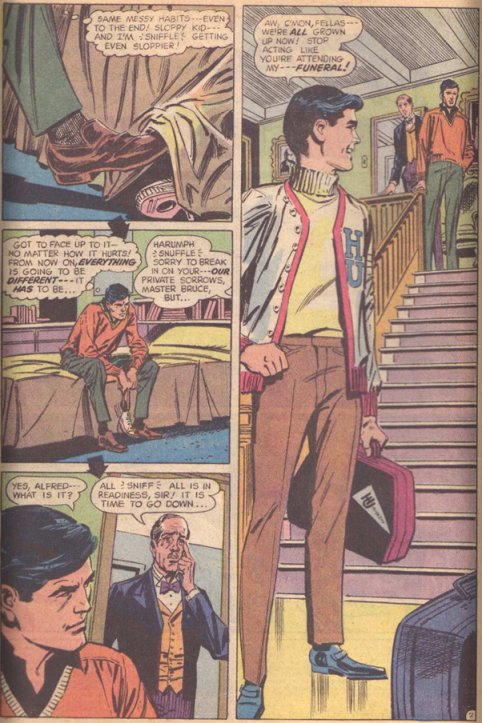
From the opening sequence of Batman #217. Cover-dated, Dec. 1969. Script by Frank Robbins. Pencils by Irv Novick and inks by Dick Giordano.
New Carthage! (Dan laughs) I always loved that name!
It’s 20 miles outside Gotham City. So it’s logical enough for him to still be around.
I always assumed it was like Cornell. ‘Cause there’s Ithaca, New Carthage…
Oh, right. Good point!
He would be smart enough and have the money to go to an Ivy League school. It was suburban but not so much that he was out in the middle of nowhere. That’s always just kind of how I saw it.
Back then, getting into college was not such a feat. I was talking on the phone last night with an old friend who went to St. Louis U. with me and for both of us it wasn’t a big deal. I don’t remember … You passed a lot of tests as a senior in high school and you signed a lot of stuff and somewhere in there I passed the test for St. Louis University but I didn’t know I was going until I received a letter. Not having anything else to do with my life but work in my father’s store, I thought, “OK, I’ll go to college.” Now, you know, they start preparing for it in grade school.
—
For the complete DENNY O’NEIL INTERVIEWS INDEX of stories, click here.
—


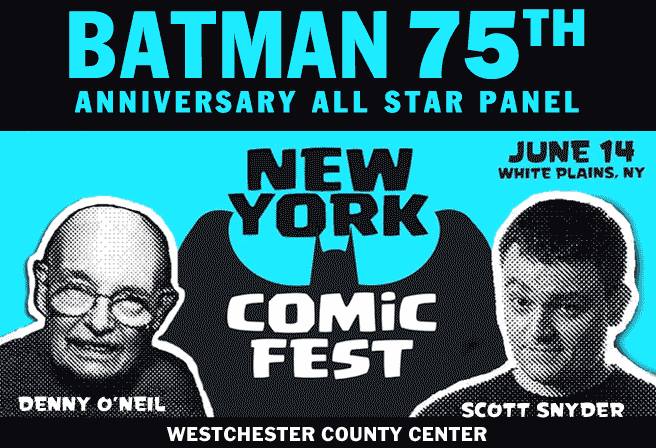
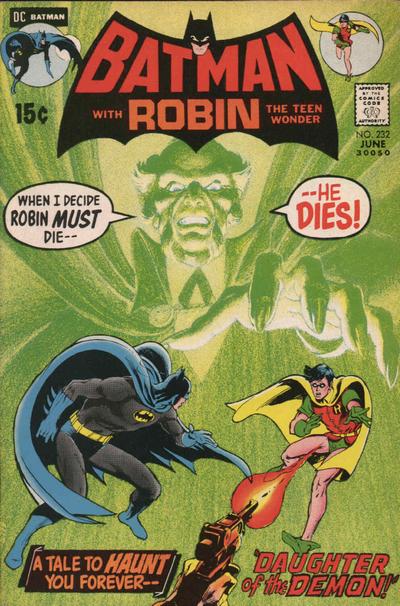
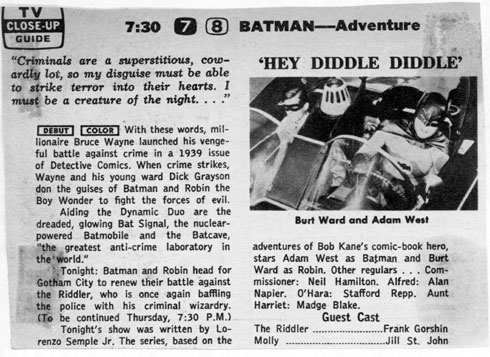

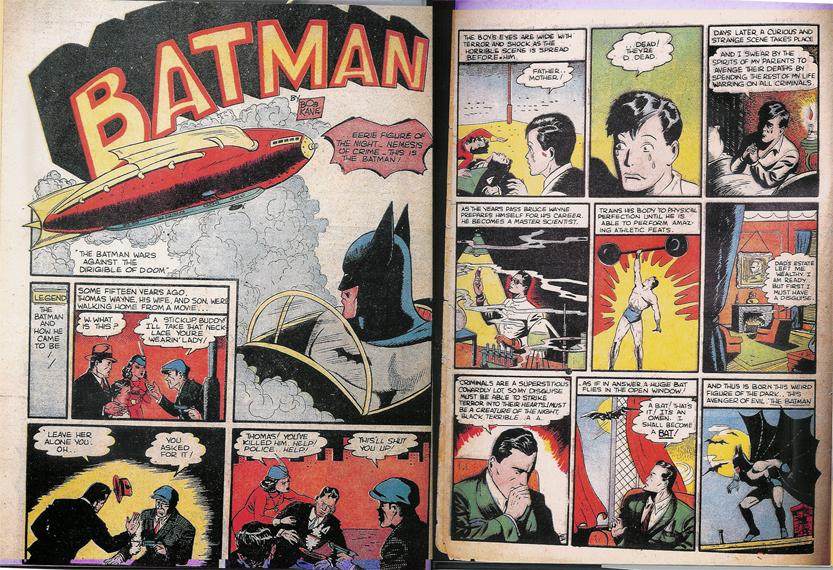
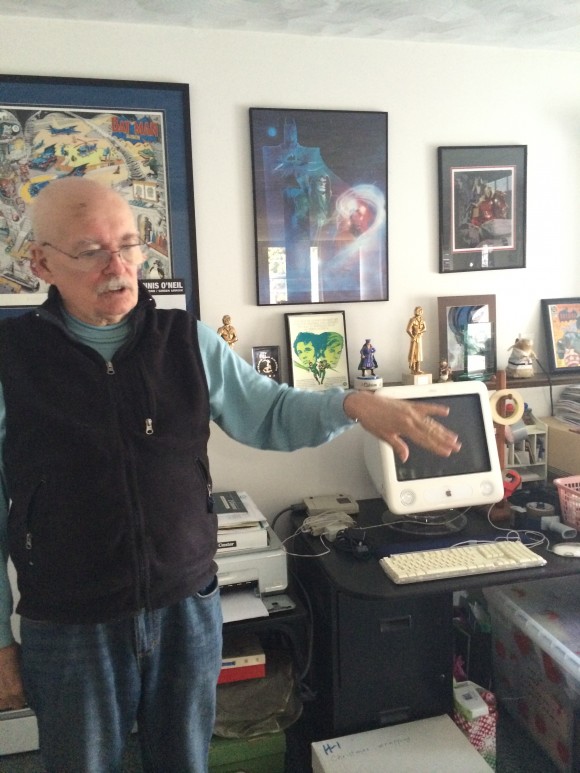
June 10, 2014
Loving these interview snippets so much…and I like the new name for this feature!